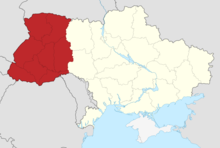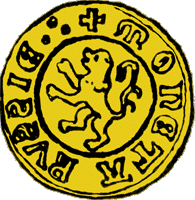Western Ukraine
| Western Ukraine | |
|---|---|
 Regions that are included in the West of Ukraine | |
| Area | |
| • Coordinates | 50°N 26°E / 50°N 26°E |
 Map of the Kingdom of Galicia–Volhynia in the 13th/14th century | |


Western Ukraine (
The area of Western Ukraine was ruled by various polities, including the Kingdom of Galicia–Volhynia, which became part of the Polish–Lithuanian Commonwealth, but also the Principality of Moldavia; it would then variously come under rule of the Austrian Empire, Austria-Hungary, the Second Polish Republic, the Kingdom of Romania, and finally the Soviet Union (via the Ukrainian Soviet Socialist Republic) in 1939 and 1940 following the invasion of Poland and the Soviet occupation of Bessarabia and Northern Bukovina, with the borders finalized after the end of World War II. After the dissolution of the Soviet Union, it became part of the independent Ukrainian state.
Western Ukraine is known for its exceptional natural and cultural heritage, several sites of which are on the
The city of
History

Western Ukraine, takes its roots from the Kingdom of Galicia–Volhynia, a successor of Kievan Rus' formed in 1199 after the weakening of Kievan Rus' and attacks from the Golden Horde.
Following the 14th century
The territory of Bukovina was part of Moldavia since its formation by voivode Dragoș, who was departed by the Kingdom of Hungary, during the 14th century.
After the 18th century
In 1775, following the Russo-Turkish Treaty of Küçük Kaynarca, Moldavia lost to the Habsburg monarchy its northwestern part, which became known as Bukovina, and remained under Austrian administration until 1918.
Interbellum and World War II
Following the defeat of
At the onset of
Post-War
After the defeat of Germany in World War II, in May 1945 the Soviet Union incorporated all territories of current Western Ukraine into the Ukrainian SSR.[12] Between 1944 and 1946, a population exchange between Poland and Soviet Ukraine occurred in which all ethnic Poles and Jews who had Polish citizenship before September 17, 1939 (date of the Soviet Invasion of Poland) were transferred to post-war Poland and all ethnic Ukrainians to the Ukrainian SSR, in accordance with the resolutions of the Yalta and Tehran conferences and the plans about the new Poland–Ukraine border.[14]
Recent history
During the 2022 Russian invasion of Ukraine, Russia attacked Ukrainian military facility near the city of Lviv,[15] in Western Ukraine with cruise missiles. Later in March Russia performed missile attacks on oil depots in Lviv,[16] Dubno[17][18] and Lutsk.[19]
Divisions

Western Ukraine includes such lands as
The history of Western Ukraine is closely associated with the history of the following lands:
- Easternmost region of Central Europe in official use since 1775, controlled by the Kingdom of Romania after World War I, and half of it ceded to the USSR in 1940 (reconfirmed by Paris Peace Treaties, 1947)
- Eastern Galicia (Ukrainian: Halychyna), once a small kingdom with Lodomeria (1914), province of the Austrian Empire until the dissolution of Austria-Hungary in 1918. See also: crownland of the Kingdom of Galicia and Lodomeria
- Red Ruthenia since medieval times in the area known today as Eastern Galicia.
- West Ukrainian People's Republic declared in late 1918 until early 1919 and claiming half of Galicia with mostly Polish city dwellers (historical sense).
- Carpatho-Ukraine region within Czechoslovakia (1939) under Hungarian control until the Nazi occupation of Hungary in 1944.
- General Government of Galicia and Bukovina captured from Austria-Hungary during World War I.
- Ținutul Suceava (Kingdom of Romania)
- West Belarusas well as Volhynia.
- Zakarpattia or Carpathian Ruthenia presently in the Zakarpattia Oblast of western Ukraine.
Administrative and historical divisions
| Administrative region | Area sq km | Population (2001 Census) |
Population Estimate (Jan 2012) |
|---|---|---|---|
| Chernivtsi Oblast | 8,097 | 922,817 | 905,264 |
| Ivano-Frankivsk Oblast | 13,927 | 1,409,760 | 1,380,128 |
| Khmelnytskyi Oblast | 20,629 | 1,430,775 | 1,320,171 |
| Lviv Oblast | 21,831 | 2,626,543 | 2,540,938 |
| Rivne Oblast | 20,051 | 1,173,304 | 1,154,256 |
| Ternopil Oblast | 13,824 | 1,142,416 | 1,080,431 |
| Volyn Oblast | 20,144 | 1,060,694 | 1,038,598 |
| Zakarpattia Oblast | 12,753 | 1,258,264 | 1,250,759 |
| Total | 131,256 | 10,101,756 | 9,765,281 |
Cultural characteristics
Differences with rest of Ukraine
"Perhaps, if Ukraine did not have its western regions, with
Soviet Ukraine under the Molotov–Ribbentrop Pact, brought to the country a rebellious and free spirit."
Andrey Kurkov in an opinion piece about Euromaidan on BBC News Online (28 January 2014)[20]
Ukrainian is the dominant language in the region. Back in the schools of the Ukrainian SSR learning Russian was mandatory; currently, in modern Ukraine, in schools with Ukrainian as the language of instruction, classes in Russian and in other minority languages are offered.[10][21]
In terms of religion, the majority of adherents share the Byzantine Rite of Christianity as in the rest of Ukraine, but due to the region escaping the 1920s and 1930s Soviet persecution, a notably greater church adherence and belief in religion's role in society is present. Due to the complex post-independence religious confrontation of several church groups and their adherents, the historical influence played a key role in shaping the present loyalty of Western Ukraine's faithful. In Galician provinces, the Ukrainian Greek Catholic Church has the strongest following in the country, and the largest share of property and faithful. In the remaining regions: Volhynia, Bukovina and Transcarpathia the Orthodoxy is prevalent. Outside of Western Ukraine the greatest in terms of Church property, clergy, and according to some estimates, faithful, is the Ukrainian Orthodox Church (Moscow Patriarchate). In the listed regions (and in particular among the Orthodox faithful in Galicia), this position is notably weaker, as the main rivals, the Ukrainian Orthodox Church – Kyiv Patriarchate and the Ukrainian Autocephalous Orthodox Church, have a far greater influence. Within the lands of the Ukrainian Greek Catholic Church, the largest Eastern Catholic Church, priests' children often became priests and married within their social group, establishing a tightly-knit hereditary caste.[22]
Noticeable cultural differences in the region (compared with the rest of Ukraine especially Southern Ukraine and Eastern Ukraine) are more "negative views"[clarification needed] on the Russian language[23][24] and on Joseph Stalin[25] and more "positive views"[clarification needed] on Ukrainian nationalism.[26] A higher percentage of voters in Western Ukraine supported Ukrainian independence in the 1991 Ukrainian independence referendum than in the rest of the country.[27][28]

In a poll conducted by Kyiv International Institute of Sociology in the first half of February 2014 0.7% of polled in West Ukraine believed "Ukraine and Russia must unite into a single state", nationwide this percentage was 12.5, this study did not include polls in the Luhansk and Donetsk regions of Ukraine.[29]
During
Demographics
Religion
Religion in western Ukraine (2016)[34]

According to a 2016 survey of
Of the total population, 97.7% declared to be
See also
Notes and references
- OCLC 902306
- ^ "Kam'ianets-Podilskyi historical". kampod.name (in Ukrainian). Archived from the original on 2011-04-30. Retrieved 2011-05-10.
- ^ Bochenek 1980, p. 93.
- ^ Welcome to Ukraine: About Kamianets-Podilskyi Archived 2013-05-13 at the Wayback Machine MIBS Travel
- ^ A trip to historic Kamianets-Podilskyi: crossroads of many cultures Archived 2016-03-04 at the Wayback Machine, Roman Woronowycz, Kyiv Press Bureau.
- ^ "ЗАХІДНА УКРАЇНА, ЯК ТЕРМІН". resource.history.org.ua. Archived from the original on 2022-01-23. Retrieved 2022-03-23.
- ^ UNESCO: Carpathian, July 2011
- ISBN 0199253404, archivedfrom the original on February 11, 2023, retrieved January 27, 2014
- ISBN 0-7190-3727-1, archivedfrom the original on 2023-02-11, retrieved 2020-11-21
- ^ ISBN 978-0-19-530546-3
- ^ (in Polish) rabacja galicyjska Archived 7 June 2011 at the Wayback Machine in Internetowa encyklopedia PWN
- ^ ISBN 1857430581(page 849)
- ^ Arne Bewersdorf. "Hans-Adolf Asbach. Eine Nachkriegskarriere" (PDF). Band 19 Essay 5 (in German). Demokratische Geschichte. pp. 1–42. Archived (PDF) from the original on April 3, 2016. Retrieved June 26, 2013.
- ^ ""Переселение белорусов из Польши и Полесская область (1944-1947 гг.)"". 30 November 2019. Archived from the original on 2021-09-01. Retrieved 2022-03-11.
- ^ "Russia strikes Ukraine army base near Poland as it widens attacks". Aljazeera News Agency. 14 March 2022. [1] Archived 2022-03-23 at the Wayback Machine
- ^ "The Lviv oil depot was completely destroyed by a Russian missile - the Regional State Administration". Ukrainska Pravda. 27 March 2022.[2] Archived 2022-03-29 at the Wayback Machine
- ^ "Rivne Administration: Oil depot in Dubno razed to the ground after missile strike". Ukrainska Pravda. March 27, 2022.[3] Archived 2022-03-29 at the Wayback Machine
- ^ "Russian rocket hits an oil depot in the Rivne region". Ukrainska Pravda. March 28, 2022.[4] Archived 2022-03-29 at the Wayback Machine
- ^ "Lutsk missile strike: Head of Volyn region shares details". Ukrainska Pravda. March 28, 2022.[5] Archived 2022-03-29 at the Wayback Machine
- ^ Viewpoint: Ukrainian writer Andrey Kurkov on the protests Archived 2018-10-11 at the Wayback Machine, BBC News (28 January 2014)
- ^ The Educational System of Ukraine Archived 2020-07-12 at the Wayback Machine, Nordic Recognition Network, April 2009.
- ISBN 978-1-4426-9728-7. Archivedfrom the original on 2023-02-11. Retrieved 2021-01-11.
- RATING(25 May 2012)
- ^ "Poll: Over half of Ukrainians against granting official status to Russian language - Dec. 27, 2012". 27 December 2012. Archived from the original on 8 September 2014. Retrieved 7 March 2013.
- ^ (in Ukrainian) Ставлення населення України до постаті Йосипа Сталіна Attitude population Ukraine to the figure of Joseph Stalin Archived 2018-09-17 at the Wayback Machine, Kyiv International Institute of Sociology (1 March 2013)
- Timothy D. Snyder, The New York Review of Books (21 September 2010). Archived 2015-10-24 at the Wayback Machine.
- .
- ^ Ivan Katchanovski. (2009). Terrorists or National Heroes? Politics of the OUN and the UPA in Ukraine Archived 2017-08-08 at the Wayback Machine Paper prepared for presentation at the Annual Conference of the Canadian Political Science Association, Montreal, June 1–3, 2010
- ^ "How relations between Ukraine and Russia should look like? Public opinion polls' results", Kyiv International Institute of Sociology (4 March 2014). Archived 2017-12-23 at the Wayback Machine.
- ^ Центральна виборча комісія України - WWW відображення ІАС "Вибори народних депутатів України 2012" Archived 2012-10-16 at the Wayback Machine
CEC substitues Tymoshenko, Lutsenko in voting papers Archived 2014-08-13 at the Wayback Machine - ISBN 978-3-525-36912-8(page 396)
- openDemocracy.net(3 January 2011)
- The Jamestown Foundation. Archived from the original on 2016-03-28.(PDF) on 2013-05-15.
Kuzio, Taras (5 October 2007). "UKRAINE: Yushchenko needs Tymoshenko as ally again" (PDF). Oxford Analytica. Archived from the original - ^ Razumkov Centerin collaboration with the All-Ukrainian Council of Churches. pp. 27-29.
External links
 Western Ukraine travel guide from Wikivoyage
Western Ukraine travel guide from Wikivoyage Media related to Western Ukraine at Wikimedia Commons
Media related to Western Ukraine at Wikimedia Commons
